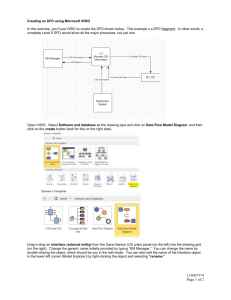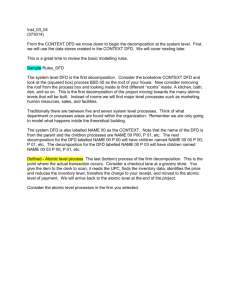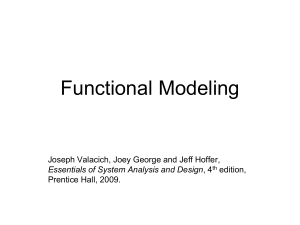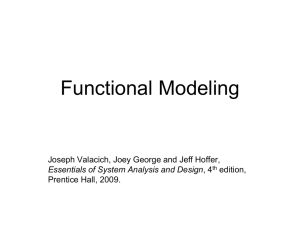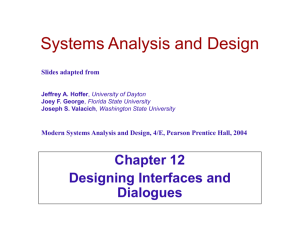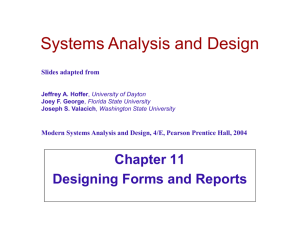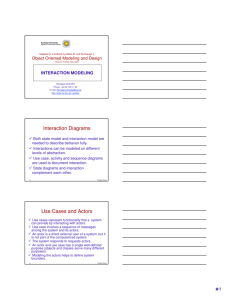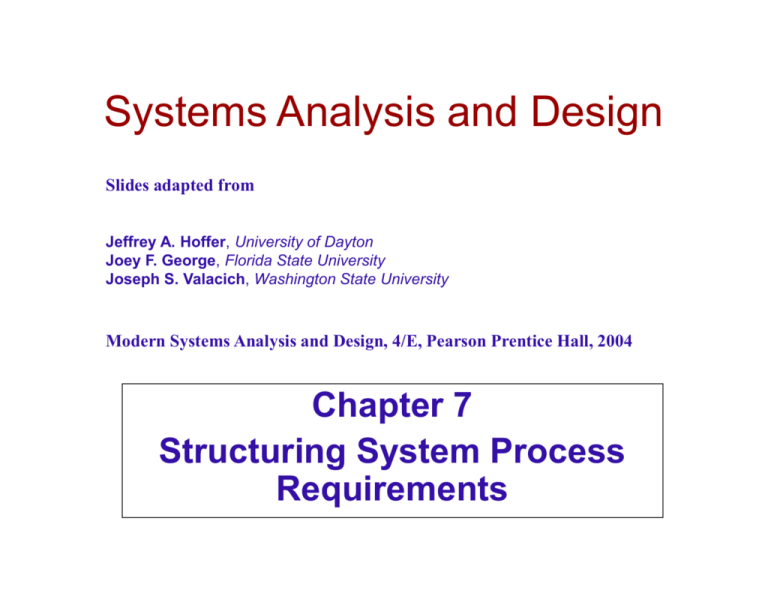
Systems Analysis and Design
Slides adapted from
Jeffrey A. Hoffer, University of Dayton
Joey F. George, Florida State University
Joseph S. Valacich, Washington State University
Modern Systems Analysis and Design, 4/E, Pearson Prentice Hall, 2004
Chapter 7
Structuring System Process
Requirements
Process Modeling
7-2
Graphically represent the processes that
capture, manipulate, store, and distribute data
between a system and its environment and
among system components
Utilize information gathered during requirements
determination
Processes and data structures are modeled
© R Gustas
Process Modeling (cont.)
Deliverables and Outcomes
7-3
Context data flow diagram (DFD)
Scope of system
DFDs of current physical and logical system
Enables analysts to understand current
system
DFDs of new logical system
Technology independent
Show data flows, structure, and functional
requirements of new system
Thorough description of each DFD component
© R Gustas
Data Flow Diagram (DFD)
7-4
A picture of the movement of data between
external entities and the processes and data
stores within a system
Difference from system flowcharts:
DFDs depict logical data flow independent of
technology
Flowcharts depict details of physical systems
© R Gustas
DFD Symbols
7-5
© R Gustas
DFD Symbols (cont.)
Process: work or actions performed on data
(inside the system)
Data store: data at rest (inside the system)
Source/sink: external entity that is origin or
destination of data (outside the system)
Data flow: arrows depicting movement of
data
7-6
© R Gustas
DFD Diagramming Rules
Process
No process can have
only outputs or only
inputs…processes
must have both
outputs and inputs.
Process labels should be verb phrases.
7-7
© R Gustas
DFD Diagramming Rules
Data Store
All flows to or from a data store
must move through a process.
Data store labels should be noun phrases.
7-8
© R Gustas
DFD Diagramming Rules
Source/Sink
No data moves directly between external entities without
going through a process.
Interactions between external entities without intervening
processes are outside the system and therefore not
represented in the DFD.
Source and sink labels should be noun phrases.
7-9
© R Gustas
DFD Diagramming Rules
Data Flow
Bidirectional flow
between process
and data store is
represented by two
separate arrows.
Forked data flow
must refer to exact
same data item (not
different data items)
from a common
location to multiple
destinations.
7-10
© R Gustas
DFD Diagramming Rules
Data Flow (cont.)
Joined data flow
must refer to exact
same data item (not
different data items)
from multiple
sources to a
common location.
Data flow cannot
go directly from a
process to itself,
must go through
intervening
processes.
7-11
© R Gustas
DFD Diagramming Rules
Data Flow (cont.)
Data flow from a process to a data
store means update (insert, delete or
change).
Data flow from a data store to a
process means retrieve or use.
Data flow labels should be noun
phrases.
7-12
© R Gustas
Functional Decomposition
An iterative process of breaking a system
description down into finer and finer detail
High-level processes described in terms of
lower-level sub-processes
DFD charts created for each level of detail
7-13
© R Gustas
DFD Levels
Context DFD
Overview of the organizational system
Level-0 DFD
Representation of system’s major processes at
high level of abstraction
Level-1 DFD
Results from decomposition of Level 0 diagram
Level-n DFD
7-14
Results from decomposition of Level n-1 diagram
© R Gustas
Context diagram shows the system boundaries, external entities that
interact with the system, and major information flows between entities and the
system.
NOTE: only one process symbol, and no data stores shown.
7-15
© R Gustas
Level-0 DFD
7-16
© R Gustas
Level-1 DFD
Level-1 DFD shows the sub-processes of one of the processes in the Level-0 DFD.
This is a Level-1 DFD for Process 4.0.
7-17
© R Gustas
Level-n DFD
Level-n DFD
shows the sub-processes of one of the processes in the Level n-1 DFD.
This is a Level-2 DFD for Process 4.3.
Processes are labeled 4.3.1, 4.3.2, etc. If this is the lowest level of
the hierarchy, it is called a primitive DFD.
7-18
© R Gustas
DFD Balancing
The conservation of inputs and outputs to a data
flow process when that process is decomposed
to a lower level
Balanced means:
Number of inputs to lower level DFD equals number
of inputs to associated process of higher-level DFD
Number of outputs to lower level DFD equals number
of outputs to associated process of higher-level DFD
7-19
© R Gustas
2 inputs
1 output
Unbalanced DFD
7-20
© R Gustas
Balanced
DFD
7-21
© R Gustas
Balanced
DFD (cont.)
1 input
4 outputs
These are balanced because the
numbers of inputs and outputs to
Process 1.0 of the Level-0 diagram
equals the number of inputs and
outputs to the Level-1 diagram.
7-22
© R Gustas
A composite data flow at
a higher level may be
split if different parts go
to different processes in
the lower level DFD.
Data Flow Splitting
7-23
© R Gustas
More DFD Rules
7-24
© R Gustas
Four Different Types of DFD
Current Physical
Process labels identify technology (people or
systems) used to process the data.
Data flows and data stores identify actual name of
the physical media.
Current Logical
Physical aspects of system are removed as much
as possible.
Current system is reduced to data and processes
that transform them.
7-25
© R Gustas
Four Different Types of DFD
(cont.)
7-26
New Logical
Includes additional functions
Obsolete functions are removed
Inefficient data flows are reorganized
New Physical
Represents the physical implementation of
the new system
© R Gustas
Guidelines for Drawing DFDs
7-27
Completeness
DFD must include all components necessary
for system.
Each component must be fully described in
the project dictionary or CASE repository.
Consistency
The extent to which information contained
on one level of a set of nested DFDs is also
included on other levels.
© R Gustas
Guidelines for Drawing DFDs (cont.)
Timing
Time is not represented well on DFDs.
Best to draw DFDs as if the system has never started
and will never stop.
Iterative Development
Analyst should expect to redraw diagram several
times before reaching the closest approximation to
the system being modeled.
Primitive DFDs
Lowest logical level of decomposition
Decision has to be made when to stop decomposition
7-28
© R Gustas
Guidelines for Drawing DFDs
(cont.)
Rules for stopping decomposition
7-29
When each process has been reduced to a
single decision, calculation or database
operation
When each data store represents data
about a single entity
When the system user does not care to
see any more detail
© R Gustas
Guidelines for Drawing DFDs
(cont.)
Rules for stopping decomposition (continued)
7-30
When every data flow does not need to be split
further to show that data are handled in various
ways
When you believe that you have shown each
business form or transaction, online display and
report as a single data flow
When you believe that there is a separate process
for each choice on all lowest-level menu options
© R Gustas
Using DFDs as Analysis Tools
Gap Analysis
The process of discovering discrepancies
between two or more sets of data flow
diagrams or discrepancies within a single
DFD
Inefficiencies in a system can often be
identified through DFDs.
7-31
© R Gustas
Using DFDs in Business
Process Reengineering
Before: Credit approval process
required six days
7-32
After: allowed to increase the
number of contracts by 100 times
© R Gustas
Use Cases
Depiction of a system’s behavior or
functionality under various conditions as
the system responds to requests from
users
Representation of a business process
that has some specific purpose
7-33
© R Gustas
UML Use Case Diagram
Symbols
Use Case
Actor
Boundary
Connection
<<include>>
Include relationship
Extend relationship
7-34
<<extend>>
© R Gustas
What is an Actor?
Actor is an external entity that interacts with
the system.
Most actors represent user roles, but actors
can also be external systems.
An actor is a role, not a specific user; one
user may play many roles, and an actor may
represent many users.
7-35
© R Gustas
What is a Boundary?
A boundary is the dividing line between
the system and its environment.
Use cases are within the boundary.
Actors are outside of the boundary.
7-36
© R Gustas
What is a Use Case
Connection?
A connection is an association between
an actor and a use case.
Depicts a usage relationship
Connection does not indicate data flow
7-37
© R Gustas
What is an <<extend>>
Relationship?
A (optional) connection between two
use cases
Extends a use case by adding new
behavior or actions
Specialized use case extends the
general use case
7-38
© R Gustas
7-39
© R Gustas
What is an <<include>>
Relationship?
A (mandatory) connection between two
use cases
Indicates a use case is always used
(invoked) by another use case
Links to general purpose functions,
used by many other use cases
7-40
© R Gustas
7-41
© R Gustas
Summary
In this chapter you learned how to:
7-42
Understand logical process modeling via data flow
diagrams (DFDs).
Draw DFDs of well structured process models.
Decompose DFDs into lower-level diagrams.
Balance high-level and low-level DFDs.
Explain differences between current physical,
current logical, new physical, and new logical
DFDs.
Use DFDs for analyzing information systems.
Use case diagrams.
© R Gustas





